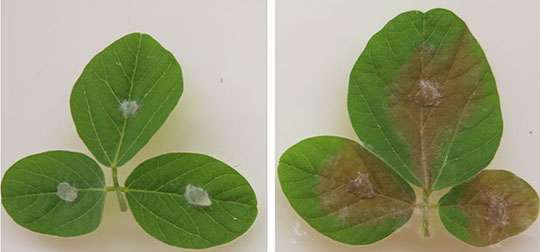Potential biological control agents found for fungal diseases of soybean

Viruses are everywhere. They affect all forms of life, from complex mammals down to the mere fungus. We may not give much thought to fungal viruses, or mycoviruses, but new research from the University of Illinois suggests they deserve a closer look.
"There's been a lot of work done with human and animal and plant viruses. There isn't as much known about fungal viruses or insect viruses, because if they get infected with a virus, no one cares," explains U of I and USDA ARS virologist Leslie Domier.
It turns out there are good reasons to care about mycoviruses. Fungal diseases account for approximately 10 percent yield losses annually in corn and soybean. When certain mycoviruses infect those fungi, they can become less virulent – good news for crop yields. These forms were the targets of a recent investigation by Domier and his colleagues.
"In addition to viruses that make fungi less virulent, we were also looking for those that might be transmitted outside of the fungus the way a cold virus is transmitted, where you can pick it up off a surface without having direct contact with another person. Therefore, we were particularly interested in viruses that were encapsidated, or that formed virus particles," Domier explains.
The team extracted genetic material, DNA and RNA, from five major types of plant-pathogenic fungi and used computers to search for genetic sequences that resembled those of known viruses.
"We found a lot of sequences that were very similar to previously described fungal viruses, but we also found some encapsidated forms that were similar to plant viruses. Those were the ones we were most interested in, because they reduce fungal virulence and can be transmitted outside the fungus," he says.
This key combination may make it possible for these viruses to be used as biological control agents. "Some mycoviruses have been shown in laboratory or greenhouse studies to be very effective biocontrol agents," Domier says. One day, the encapsidated forms they discovered may be sprinkled on a field to kill pathogenic fungi and improve soybean yield.
Interestingly, the research could also improve medical treatment options for human fungal diseases.
"The biochemical pathways in fungi are relatively close to humans, so it's often difficult to find something that will kill a fungus and not damage the person. Ultimately, we are hoping to explore whether we can use mycoviruses to reduce the severity of human disease to the point where normal immune response could clear the disease from the body," Domier says.
The article, "Identification of diverse mycoviruses through metatranscriptomics characterization of the viromes of five major fungal plant pathogens," is published in the Journal of Virology.
More information: Shin-Yi Lee Marzano et al. Identification of Diverse Mycoviruses through Metatranscriptomics Characterization of the Viromes of Five Major Fungal Plant Pathogens, Journal of Virology (2016). DOI: 10.1128/JVI.00357-16
Journal information: Journal of Virology
Provided by University of Illinois at Urbana-Champaign




















